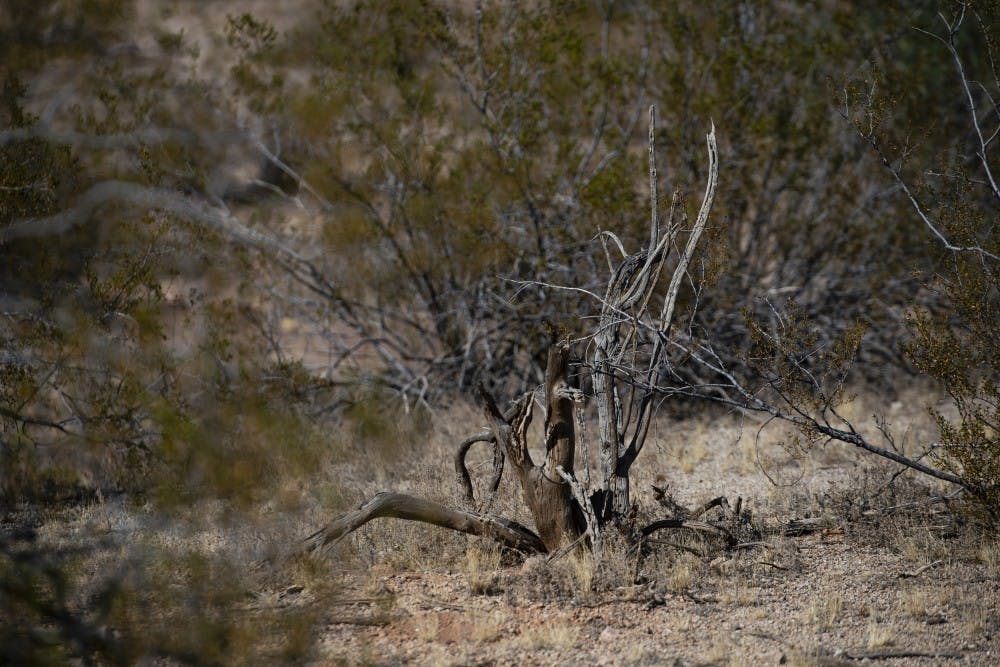Dryland litter cycles, which are the process of dead plant material decomposing, may be contributing to climate change and are not yet understood, according to research by ASU associate professor Heather Throop and research ecologist Jayne Belnap from the U.S. Geological Survey.
Their new work sheds light on this cycle and focuses specifically on how it occurs in deserts.
This cycle may seem simple, but it's largely misunderstood in the scientific community on how it occurs in the desert, and just how this cycle plays a role in the release of carbon into the atmosphere.
Belnap said most research occurs in forested landscapes, meaning most prior knowledge comes from work done in greener areas and not in the desert.
Throop, who has joint appointments in the School of Earth and Space Exploration and the School of Life Sciences, said understanding how plant litter decomposition works in drylands can help predict climate change.
“We have this really big misunderstanding in drylands in what controls that litter cycle,” Throop said. “We think that one of the things we don’t fully understand is that this litter moves around a lot so material doesn't fall into one place.
"We know that drylands account for a substantial amount of carbon stored worldwide, so if we want to predict climate change we need to understand these systems.”
The main motivation for the work is to try and understand what controls the amount of carbon in the atmosphere, Throop said.
“We have a very small amount of carbon in the atmosphere … but that carbon profoundly affects climate and that's changing right now," she said. "And that carbon is coming from sources on Earth … a lot is from burning fossil fuels … but plants and soils are storing a substantial amount."
As global ocean temperatures rise, climate change is becoming a bigger concern among the world's nations and their scientists. Understanding dryland litter cycles can help better explain these changes.
Throop said if they can discover a way to keep more of the carbon from dryland plant litter in the soil, and not release into the atmosphere, it could help combat climate change in a small way.
Rhode Island College assistant professor of biology Daniel Hewins, who has worked with Throop in the past, said limiting plant litter production reduces the carbon sponge that naturally soaks up carbon that could end up in the atmosphere.
He also said limiting the litter amount would result in further complications because of plant litter's role in an ecosystem. The effectiveness of limiting the carbon plant litter releases may result in other problems if not done correctly.
“Prior to burning fossil fuels, the world was kind of at a point where it was fairly well balanced," Hewins said. "The uptake of carbon was fairly equal to the amount of carbon being respired ... We disrupted that balance. At this stage, every atom of carbon we can conserve is going to help offset climate change. But I wouldn't look at plant litter as a contributor to global warming because it's just part of nature.”
According to a U.N. report, about two-thirds of the greenhouse gasses admitted into the atmosphere come from carbon dioxide, making it one of the primary causes for climate change.
“What it does is give us a better understanding of how much carbon is going which direction in deserts,” Belnap said. “We might discover desserts are huge emitters of carbon or they are huge sinks of carbon.”
Belnap said the research is only in its beginning stages. Just how different the dryland litter cycle is to mesic (forest) system cycles still needs to be further tested.
Both scientists also plan to work on figuring out how much of the carbon from the cycle is released into the atmosphere or remains in the soil.
“We want to use drones, some structural learning and look at large areas in drylands and be able to accurately quantify that,” School of Earth and Space Exploration research technician Nicole Hornslein said.
Still, this research is a crucial first step in figuring out how dryland litter cycles occur and its role on the environment as a whole.
“Our goal is to understand these processes,” Throop said. “But ultimately there is a lot of interest now to understand these processes in order to maximize the carbon stored in soil, stored in litter, and not released into the atmosphere.”
Reach the reporter at wmyskow@asu.edu and follow @wmyskow on Twitter.
Like The State Press on Facebook and follow @statepress on Twitter.

Wyatt Myskow is the project manager at The State Press, where he oversees enterprise stories for the publication. He also works at The Arizona Republic, where he covers the cities of Peoria and Surprise.




